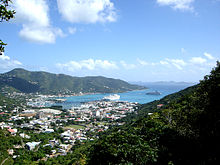 Road Town, Tortola | |
| Currency | U.S. dollar (USD) |
|---|---|
| 1 Apr - 31 Mar | |
Trade organisations | CARICOM (Associate member) |
| Statistics | |
| GDP | $1.027 billion (2017 est.)[1] |
| GDP rank | 177th (nominal) / 190th (PPP) |
GDP growth | 3.2% (2017 est.)[1] |
GDP per capita | $34,246 (2017 est.)[1] |
GDP by sector | agriculture: 1.8%, industry: 6.2%, services: 92% (2005 est.) |
| 0.85% (2015 est.)[1] | |
Population below poverty line | NA% (2004) |
Labour force | 12,770 (2004) |
Labour force by occupation | agriculture: 0.6%, industry: 40%, services: 59.4% (2005 est.) |
| Unemployment | 8.7% (2010 est.) |
Main industries | tourism, financial services |
| External | |
| Exports | $38.5 million (2011 est.) |
Export goods | rum, fresh fish, fruits, animals; gravel, sand |
Main export partners |
|
| Imports | $275.1 million (2011 est.) |
Import goods | building materials, automobiles, foodstuffs, machinery |
Main import partners |
|
| Public finances | |
| $173.3 million (2017 est.)[1] | |
| Revenues | $310,470,000 (2016 est.)[1] |
| Expenses | $288,640,000 (2016 est.)[1] |
| Economic aid | recipient: $NA (2004) |
All values, unless otherwise stated, are in US dollars. | |
The economy of the British Virgin Islands is one of the most prosperous in the Caribbean. Although tiny in absolute terms, because of the very small population of the British Virgin Islands, in 2010 the Territory had the 19th highest GDP per capita in the world according to the CIA World factbook.[4] In global terms the size of the Territory's GDP measured in terms of purchasing power is ranked as 215th out of a total of 229 countries.[5] The economy of the Territory is based upon the "twin pillars" of financial services, which generates approximately 60% of government revenues,[6] and tourism, which generates nearly all of the rest.
Historically the British Virgin Islands has normally produced a Government budget surplus, but during the financial crisis of 2007–2008 the Territory began to run at a deficit, which continued after the global recession receded. In 2011 the Territory had its largest ever budget deficit, of US$29 million (approximately 2.6% of GDP).[7] By 2012 public debt had quadrupled from pre-crisis levels to approximately US$113 million (approximately 10.3% of GDP).[8] Nearly 84% of that public debt was attributable to a new public hospital built in Road Town between 2003 and 2014.[9] The Economist argued that deteriorating economic conditions in the British Virgin Islands were caused "not [by] sagging revenues but public-sector profligacy".[10] By 2014 public debt had been reduced to US$106 million and the annual deficit reduced to US$25 million (including budgeted capital expenditure).[11]
By 2016, the Government had returned to a primary budget surplus,[12] but public debt had increased to approximately US$141 million[13] and debt service accounted for over US$12 million of the primary surplus. However, because of an ongoing aggressive capital investment programme, and budget overruns on key public projects,[14] the Government ran dangerously low on available cash. Cash in the consolidated fund fell below US$7 million (with average monthly expenditure at nearly US$30 million), and Government accrued over US$13 million in due but unpaid invoices.[15]
- ^ a b c d e f g "2017 Budget estimates" (PDF). Government of the Virgin Islands. Archived (PDF) from the original on 9 October 2022. Retrieved 22 January 2018.
- ^ "Export Partners of British Virgin Islands". The Observatory of Economic Complexity. Retrieved 8 March 2024.
- ^ "Import Partners of British Virgin Islands". The Observatory of Economic Complexity. Retrieved 8 March 2024.
- ^ CIA - The World Factbook - Virgin Islands
- ^ "CIA Factbook - GDP by country". Archived from the original on 3 January 2014. Retrieved 3 January 2014.
- ^ "New Company Incorporations Down But Premier Remains Optimistic". 14 March 2010. Archived from the original on 3 January 2014. Retrieved 15 March 2010.
- ^ "2013 Budget Address" (PDF). BVI Government. Archived from the original (PDF) on 25 December 2014. Retrieved 13 November 2014.
- ^ "National debt grows by $73M over last decade; public sector too big – Financial Secretary". BVI News. 24 January 2013. Archived from the original on 7 April 2013.
- ^ "New hospital responsible for nearly 84% of national debt". Caribbean Medical News. 26 April 2013. Archived from the original on 13 November 2014. Retrieved 13 November 2014.
- ^ "Treasure islands in trouble". The Economist. 25 May 2013.
- ^ "2014 Budget Estimates" (PDF). Government of the Virgin Islands. Archived from the original (PDF) on 29 November 2014. Retrieved 21 November 2014.
- ^ "Update: Gov't Presents Whopping $330M Budget; Largest in History". BVI Platinum. 8 February 2016. Archived from the original on 10 February 2016. Retrieved 9 February 2016.
- ^ "Some Will Have You Believe We Have No Money - Premier Smith". BVI Platinum. 9 February 2016. Archived from the original on 10 February 2016. Retrieved 9 February 2016.
- ^ "Pier Project Balloons To $82.9M". BVI Platinum. 25 January 2016. Archived from the original on 6 October 2016. Retrieved 9 February 2016.
- ^ "National debt is $141M, unpaid invoices $13M". BVI News. 5 January 2016. Archived from the original on 6 February 2016. Retrieved 9 February 2016.